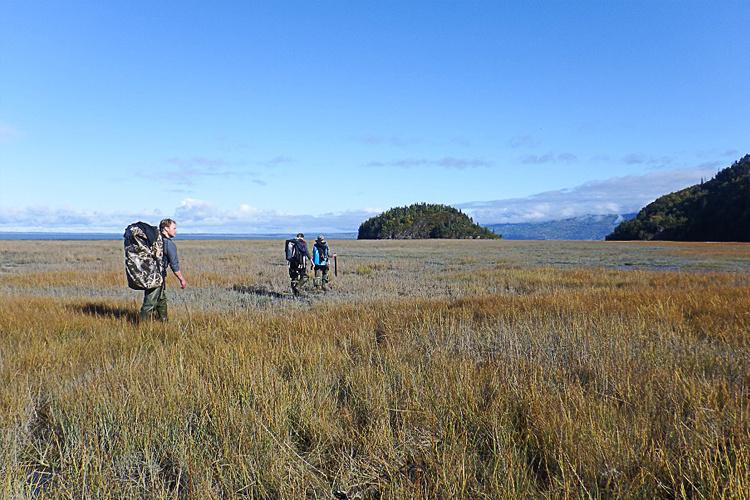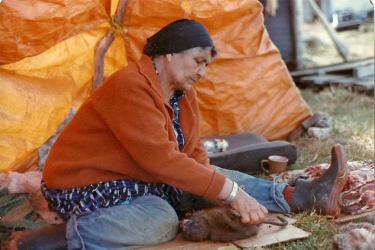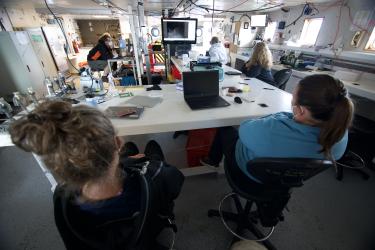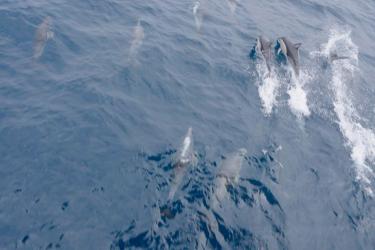
The helicopter route to the cabin and locations to deploy equipment in Chickaloon Bay. Track offloaded from our GPS tracker.
Our crew has just returned from our latest adventure- deploying acoustic moorings in a region of Cook Inlet only accessible by helicopter, Chickaloon Bay, 30 kilometers south of Anchorage.
Our base camp for the 4 nights was a remote cabin at the edge of the Chickaloon mud flats, part of the Kenai National Wildlife Refuge. It was an exciting first for us, so obviously we thought you would like to hear about it.
The cabin, formerly known as “ENSTAR cabin”, sits feet away from the ENSTAR gas pipeline feeding the city of Anchorage. The cabin is hooked up to the massive gas pipeline and includes a couple of charming and romantic gas lamps, a gas stove, and three gas burners. Definitely a "glamping" cabin.


The ADF&G warehouse with some of our toys. The strong, rich, black and smooth custom built metal silos can be seen in the doorway. - Photo by: Justin Jenniges, ADF&G
The equipment we brought and our "moorings," consisted of the scientific instruments encapsulated in a syntactic foam float, attached to an anchor and deployed via boat.
In general, the moorings consist of an echolocation click detector C-POD, inside a custom built metal “silo” built by Del Westerholt, master craftsman from Palmer, AK.
The silo is placed inside a hole that's been drilled into the ocean floor during a negative low tide using a gasoline powered posthole auger.
The silo is then further secured using cables attached to duckbill anchors in the mud so that it doesn’t float away before the hole is backfilled by the current. Only the hydrophone sensor stays above ground protected by an acoustically transparent plastic guard. This is how we do research in Alaska!
Chickaloon Bay is part of the critical habitat designated when Cook Inlet beluga whales were ESA listed in 2008. What that means is that there are whales using the area a whole lot more than an area that’s not critical habitat, such as the middle of the lower Inlet 30 miles west of Homer. Our AFSC colleagues flying the aerial surveys typically see whales in Chickaloon Bay during their surveys in summer but it’s less clear how the whales are using the bay during winter. Even more of a mystery is what the whales are doing when they are there in winter, but the silos we just deployed will help us solve this mystery.
The C-Pod (Chelonia Lid.) detects ultrasonic clicks that toothed cetaceans use to see underwater. Using sound to identify surroundings is called echolocation. This is something that dolphins, bats, frigates and submarines all do very well. During the earlier Cook Inlet beluga whale study, we were able to detect these echolocation click signals and identify that the whales were feeding because of the particular way these signals were emitted. When a beluga whale approaches its prey the click emission rate increases and when it is about to catch prey the signal switches to a buzzing mode. The three Chickaloon silos we deployed will overwinter in an area where whales are known to frequent. They will help us learn more about whether they are feeding or just waiting for the right tidal current to access Turnagain Arm. Our silo data will hopefully uncover why Chickaloon Bay is so attractive to Cook Inlet beluga whales.

Christie Osburn and Chris Garner (Department of Defense, Joint Base Elmendorf Richardson) drilling a hole to install a silo west of Burnt Island in Chickaloon Bay at a -2 feet low tide.

A silo deployed in Chickaloon Bay, holding an echolocation logger to detect bizarre and fierce sea creatures (as seen through the eyes of imagination), belugas, porpoises, and killer whales, throughout the winter, waits for the incoming tide to go underwater.
Chickaloon Bay is part of the critical habitat designated when Cook Inlet beluga whales were ESA listed in 2008. What that means is that there are whales using the area a whole lot more than an area that’s not critical habitat, such as the middle of the lower Inlet 30 miles west of Homer. Our AFSC colleagues flying the aerial surveys typically see whales in Chickaloon Bay during their surveys in summer but it’s less clear how the whales are using the bay during winter. Even more of a mystery is what the whales are doing when they are there in winter, but the silos we just deployed will help us solve this mystery.
The C-Pod (Chelonia Lid.) detects ultrasonic clicks that toothed cetaceans use to see underwater. Using sound to identify surroundings is called echolocation. This is something that dolphins, bats, frigates, and submarines all do very well. During the earlier Cook Inlet beluga whale study, we were able to detect these echolocation click signals and identify that the whales were feeding because of the particular way these signals were emitted. When a beluga whale approaches its prey the click emission rate increases and when it is about to catch prey the signal switches to a buzzing mode. The three Chickaloon silos we deployed will overwinter in an area where whales are known to frequent.They will help us learn more about whether they are feeding or just waiting for the right tidal current to access Turnagain Arm. Our silo data will hopefully uncover why Chickaloon Bay is so attractive to Cook Inlet beluga whales.

Sound recording of a beluga echolocating on its prey (likely a salmon) while chasing it until it is captured. The click rate emission increases a couple of times suggesting the prey is approached to almost capture distances and by the third approach the emission transitions to a buzz which ends in a clear capture: what you hear is the prey crushing noise generated by the powerful beluga bite. - Sound recording courtesy of Manolo Castellote
We won’t know if the silos located any beluga secrets until we return to retrieve them during spring 2018. Alaskan winters are tough and the waters of Cook Inlet are notoriously unforgiving. Thick ice begins forming in late fall and eventually covers most of the upper inlet. Areas like Chickaloon Bay, especially the mud flats where we deployed our instruments, can be entirely covered in thick blocks of ice, so the silos have a heavy duty cage that provides some protection for the C-POD hydrophone.
Our colleagues, Chris Garner and Christie Osburn from the Joint Base Elmendorf Richardson up in Knik Arm, had success overwintering silos in Eagle Bay, an area of the Inlet under similar harsh winter conditions to monitor belugas. It was clear since the early stages of the project design that we needed them in our fieldwork. Having Chris and Christie in our Chickaloon trip has been extraordinary. Over the years they have developed a sixth sense to identify the perfect type of mud to deploy silos, and a very refined technique to walk on the very dangerous sticky mud of Cook Inlet, especially at extreme low tide periods. Also, this region of the Kenai National Wildlife Refuge is grizzly and black bear prime habitat, and marine mammal biologists, with zero experience camping around bears, sounds like a nice way to provide a good meal to these bears. Having Chris in the team was a bonus because of his extensive experience working with bears and other land mammals.

Christie Osburn doing finishing touches of mud makeup to our silo deployed in Chickaloon River. - Photo by: Manolo Castellote.

The Chickaloon Bay field work crew: Left to right, Manolo Castellote, bioacoustics extraordinaire, Chris Garner, multi mammal researcher, Christie Osburn, field supertech/mud guru, and Ashley Holmes, our guest weather/mud/bear-proof videographer. Scouting for silo deployments involved walking down the Chickaloon River. - Photo by: Manolo Castellote.

Crew trying to eliminate ~50kg of gear so the helicopter can fly. - Photo by: Justin Jenniges, ADF&G



